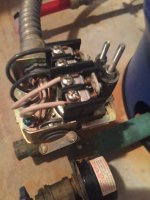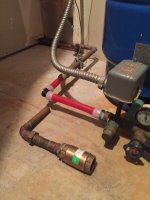Hello all. Sorry for the long post, yet I was wondering your thoughts on a recent problem that I started to have (in addition to the water hammer mystery I’ve posted about previously)
A little over a week ago, I had a pellet-drop chlorinator installed on the well, and a backwash system installed in the home. As I have high iron levels in my well water (along with other contaminants) the 19-year old Ferromax Reionator filtration system I had just wasn’t doing the job. I have never had any issues with water pressure or quantity since I’ve owned the home (I have close to an 8gpm flow rate).
Shortly after the install, I came back home after a 4-day trip out of town, and noticed that I had no water. I checked my pressure tank, and it was at “0”. Thinking my pump may have failed, I called a local driller/well specialist, and he came over and verified my pump was still outputting normal amps. Since the backwash system was scheduled to backwash every night for an hour (using 50 gallons of water per cycle), he said that the backwash system may have run my well dry? (Or maybe I had a leak somewhere?)
I contacted the guy who recommended and installed this system, and asked if it was possible that the backwashing may have depleted my well? He didn’t think that was possible. So, in order to just get enough water for a 5-minute shower now, I have to leave the well pump off for several hours, and then turn it on to hopefully fill the pressure tank to cut out at 60psi. On very rare occasions will the pump replenish the tank once it gets to cut in at 40psi. Usually, at cut in, there just isn’t enough water and it drops to “0”.
My question is: could this backwash system have run the well dry? If so, does it usually take this long to get my normal water quantity back? Never having any issues with water pressure or quantity before the installation, I’m led to believe the backwash system is the cause of this problem?
Thanks for your time in reading this lengthy post, as well as any input you may have!
A little over a week ago, I had a pellet-drop chlorinator installed on the well, and a backwash system installed in the home. As I have high iron levels in my well water (along with other contaminants) the 19-year old Ferromax Reionator filtration system I had just wasn’t doing the job. I have never had any issues with water pressure or quantity since I’ve owned the home (I have close to an 8gpm flow rate).
Shortly after the install, I came back home after a 4-day trip out of town, and noticed that I had no water. I checked my pressure tank, and it was at “0”. Thinking my pump may have failed, I called a local driller/well specialist, and he came over and verified my pump was still outputting normal amps. Since the backwash system was scheduled to backwash every night for an hour (using 50 gallons of water per cycle), he said that the backwash system may have run my well dry? (Or maybe I had a leak somewhere?)
I contacted the guy who recommended and installed this system, and asked if it was possible that the backwashing may have depleted my well? He didn’t think that was possible. So, in order to just get enough water for a 5-minute shower now, I have to leave the well pump off for several hours, and then turn it on to hopefully fill the pressure tank to cut out at 60psi. On very rare occasions will the pump replenish the tank once it gets to cut in at 40psi. Usually, at cut in, there just isn’t enough water and it drops to “0”.
My question is: could this backwash system have run the well dry? If so, does it usually take this long to get my normal water quantity back? Never having any issues with water pressure or quantity before the installation, I’m led to believe the backwash system is the cause of this problem?
Thanks for your time in reading this lengthy post, as well as any input you may have!


